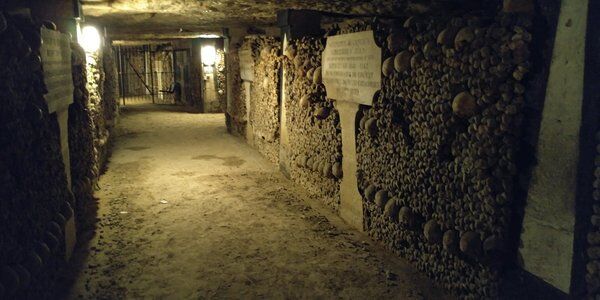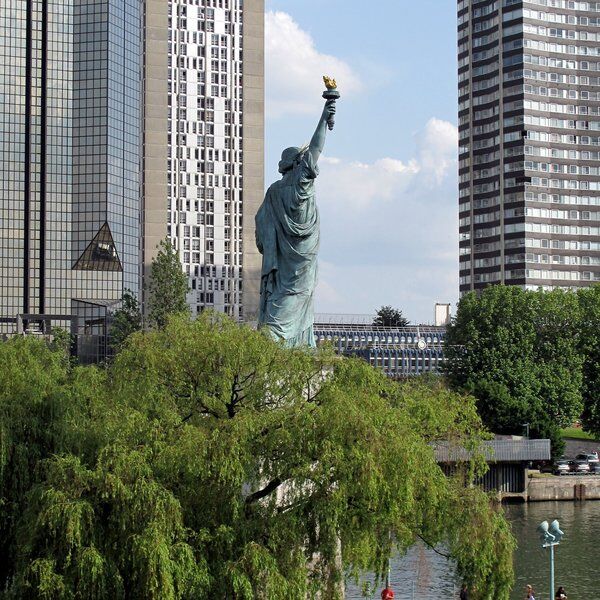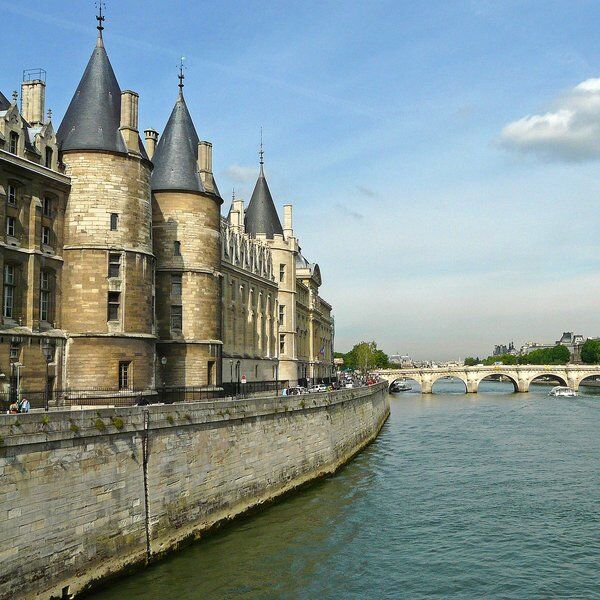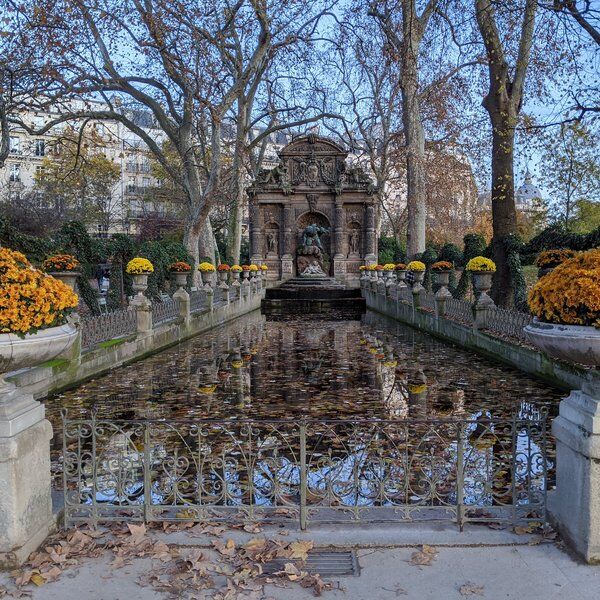Beneath the City of Light: Exploring the Paris Catacombs
Beneath the busy streets of Paris lies a hidden world known as the Paris Catacombs. This network of tunnels and galleries holds a chilling secret: the remains of over six million Parisians. Descending the 243 steps, the equivalent of a five-storey building, visitors embark on a journey through 1.5 kilometres of eerie passageways that cover an area of 11,000 square metres.
While the Catacombs draw thousands of curious visitors annually, few are aware of their extraordinary history. Initially established in the 18th century to address the city's twin concerns of sinkholes and overflowing cemeteries, these underground ossuaries were part of a larger effort to consolidate Paris's ancient stone quarries. Named after the Catacombs of Rome, the Paris Catacombs became a solution to a secular problem, gradually evolving into a haunting testament to the city's past.
The Origins of the Paris Catacombs
Paris’ Geological Makeup
The origins of the Catacombs are intertwined with Paris' geological makeup and its relentless urban expansion. Rich deposits of limestone and gypsum, mined since Roman times for construction purposes, created the foundation for the city above. However, the extraction of gypsum led to precarious underground voids, resulting in dangerous sinkholes and collapses.
In response to these hazards, King Louis XVI established the Inspection Générale des Carrières to map and stabilise the tunnels. This set the stage for the catacombs' creation.
Early Burial Practices and Growing Population
Alongside the danger from the sinkholes Paris’ early burial practices and its expanding population also led to the creation of the catacombs.
Initially, cemeteries were located outside the city walls. However, as Paris grew, these burial grounds became increasingly overcrowded, posing sanitation concerns. By the 18th century even the largest burial ground in Paris, the Cemetery of the Innocents, was facing grave overcrowding issues.
In 1780, a catastrophic event occurred at this cemetery when a wall collapsed and bones flooded a nearby basement. The unsanitary conditions and health risks associated with this occurrence and overcrowding at other cemeteries prompted authorities to seek alternative solutions.
Crisis Sparks Action
The answer? Transform the former Tombe-Issoire quarries, beneath the plain of Montrouges, into an ossuary, creating a vast underground cemetery that would eventually become the Paris Catacombs.
Over the following years, the quarries were transformed into the Paris Municipal Ossuary, known colloquially as the Paris Catacombs. In 1785, the remains of millions of Parisians were methodically moved underground, a silent and nocturnal procession led by priests. The Catacombs took on a mythical aura, drawing parallels to the ancient Roman catacombs that had long fascinated the public.
Renovating the Paris Catacombs
The Paris Catacombs underwent a remarkable transformation under the direction of Louis-Étienne Héricart de Thury in the early 19th century. Originally serving as a disorganised bone repository, Héricart de Thury transformed the Ossuary into a visitable mausoleum.
Not only did he oversee the stacking of skulls and femurs into the intricate patterns seen today, but he also utilised cemetery decorations salvaged from the Tombe-Issoire property to adorn the bone-lined walls. Monuments, archways, and foreboding inscriptions were added to enhance the eerie atmosphere, while safety measures included walling off the catacombs from the extensive tunnel network beneath Paris's Left Bank.
Today, ongoing efforts focus on preserving the ossuary's integrity and promoting its educational and historical value while respecting the dignity of the human remains interred within.
Opening to the Public
“It was a way to safely confront death and violence in the aftermath of a tumultuous, high anxiety period.”
The Paris Municipal Ossuary was officially consecrated on 7th April 1786. In 1809, Napoleon Bonapart ordered they be opened to the public by appointment. This marked a shift from their utilitarian purpose to becoming a site of mourning in the aftermath of the French Revolution; a time of prevalent death.
Visitors that weren’t there to mourn were otherwise drawn to the macabre history and chilling atmosphere inside the catacombs, a strange fascination that endures to this day. However, their accessibility has been punctuated by periodic closures and objections from religious authorities regarding the public display of human remains.
Despite these issues, public demand led to more frequent visitation allowances over time, culminating in regular daily visits. Today, guided tours are available, offering insights into the history and significance of the site. However, the catacombs' mysterious allure also attracts illicit explorers, leading authorities to strictly regulate access.

Inside the Paris Catacombs
Descending into the catacombs, visitors are greeted by a chilling inscription: Arrête, c'est ici l'empire de la Mort, which translates as “Stop, this is the realm of Death.” The catacombs stretch for miles, revealing a surreal world where skeletal remains have been artistically repurposed to shape archways, tunnels, and walls within the Ossuary.
"Bones bend into arcs [and] rise into columns, an artistic hand created a kind of mosaic out of these final remains of humanity, whose ordered regularity only adds to the profound contemplation that this space inspires."
Within the Ossuary, there’s also an absence of individual headstones or markers. People from various social classes and epochs lie side by side as a symbol of equality in death.
"The catacombs are a space of equality. You have the bones of nobles next to a pauper and you can’t tell the difference. Equality in death had long been a Christian message, but in the wake of the French Revolution, it also has resonant political undertones."
Cataphiles at the Paris Catacombs
The Paris Catacombs are actually only a fragment of a much larger underground realm known as les carrières de Paris, or "the mines of Paris." Stretching over 300 kilometres, these tunnels remain largely off-limits to the public, after a ban in 1955, yet are eagerly explored by intrepid adventurers known as cataphiles.
Despite the ban, cataphiles continue to explore the Catacombs clandestinely, navigating through blocked passages and creating makeshift entrances. These activities have led to clashes with the authorities and surprising discoveries.
In 2004 a fully equipped movie theatre was found deep within the catacombs beneath the Trocadéro. Complete with cinema screens, seating, projection equipment, and even a stocked bar and restaurant, it was attributed to a cataphile group known as les UX.
Using the Paris Catacombs throughout History
It isn’t just cataphiles that explored and repurposed areas of the Paris Catacombs throughout history. During the liberation of Paris in 1944, the catacombs were used in the resistance against Nazi Occupation as a headquarters for the French Resistance, led by Colonel Rol-Tanguy.
The catacombs also attracted attention from the entertainment industry, as the setting for the 2014 film "As Above, So Below.” This was the first time a film production was granted access to film within the catacombs. Minimal alterations were made to the environment, apart from a piano and car brought in and set on fire.
In a bold publicity stunt in 2015, Airbnb offered adventurous guests the opportunity to spend a night in the Catacombs for 350K€. However, not all incursions into the catacombs have been sanctioned; in August 2017, thieves made off with over 250K€ worth of wine after breaking into a cellar connected to the catacombs.
The Paris Catacombs and Climate Change
Aligned with the UN's 2015 Climate Plan, which mandates a drastic reduction in greenhouse gas emissions by 2050, Paris aims to position itself as Europe's greenest city by 2030. Addressing the significant energy expenditure associated with heating and cooling urban spaces is crucial to achieving these ambitious goals.
Interestingly, the constant temperature found within the Parisian tunnels presents a promising opportunity. This stable temperature serves as a potential source of geothermal energy, as noted by Fieldwork, a Paris-based architectural firm. Harnessing this geothermal energy could offer a sustainable solution for moderating temperatures, effectively cooling buildings in summer and providing warmth in winter.
Our Thoughts…
From sinkholes swallowing entire houses to overflowing cemeteries, the Catacombs' history is a tale of ingenuity and macabre necessity. Today, as visitors descend into the depths of the City of Light, they are not only confronted with the remains of Paris's past but also a potential answer to climate issues in the present and future.
Interested in finding more places like this? Try a CityDays urban exploration game - untangle cryptic clues as a team, as you are taken on a journey to the most unique, unusual and bizarre corners of Paris and beyond.







